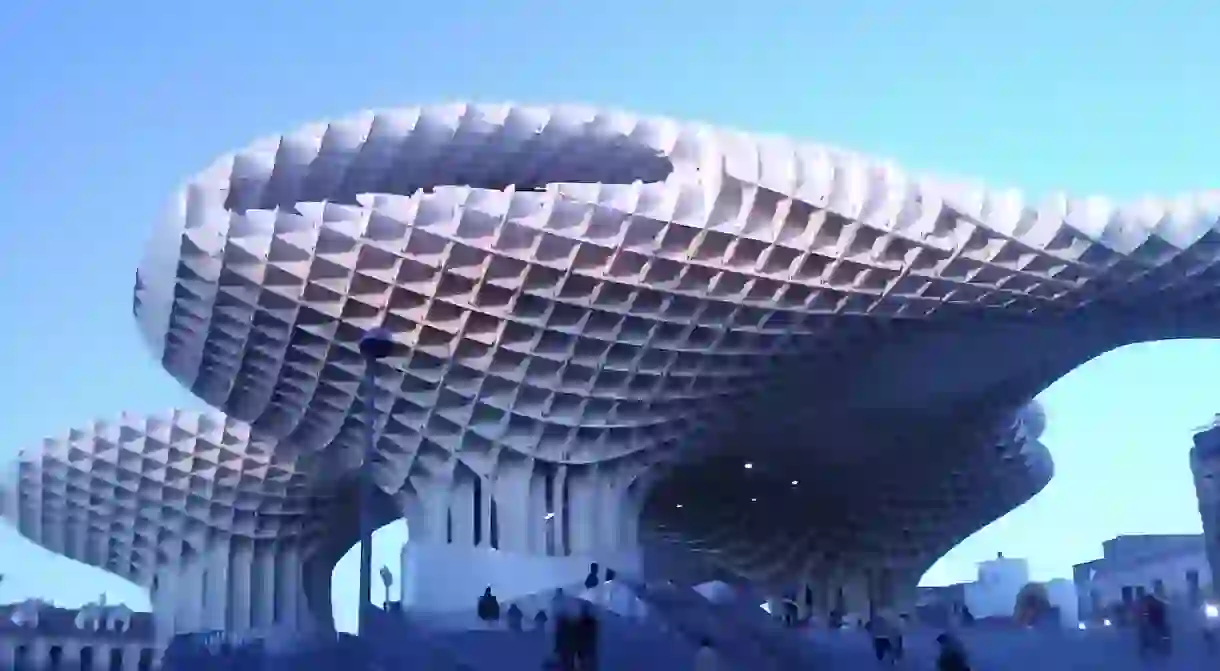A Walking Tour of Seville's Architectural Landmarks

Seville is home to some of the most striking structures in southern Spain, from its great Gothic cathedral to one of the county’s oldest and most prestigious bullrings. Take this walking tour to discover all of the Andalusian capital’s key architectural landmarks.
Seville Cathedral
Cathedral, Mosque

The church elders who conceived Seville’s great cathedral are thought to have said: ‚Hagamos una iglesia tan hermosa y tan grandiosa que los que la vieren labrada nos tengan por locos’ (‘Let us build a church so beautiful and so magnificent that those who see it will think we are mad’). The result is a towering monument to artistry, ambition and dedication that took over 100 years to build (1401–1507) and that is now the largest Gothic cathedral in the world. As in many other cities in Andalusia, its construction was motivated by the 14th century Catholic monarchs’ wish to vanquish memories of their Moorish predecessors; accordingly, Seville’s cathedral sits on the site of what used to be the city’s mosque. The building’s iconic Giralda bell tower was formerly the mosque’s minaret and is all that remains of the Islamic structure that preceded the cathedral. Its location in the heart of historic Seville means this ‘mad’ cathedral is a perfect place to start your walking tour of the city’s key architectural attractions.
Royal Alcazar Palace
Building, Cathedral, Historical Landmark

Seville’s other architectural superstar is the Royal Alcazar Palace, barely a five minute walk from the cathedral. Work on this great palace-complex – considered by many to be one of the finest examples of Mudéjar architecture in Spain – began in the 10th century, when the Umayyads built a Moorish fortress attached to the Roman city walls, but it was not until the 12th century that the first royal palace was built on the site, by the then-ruling Almohad dynasty. Additions and renovations continued, at intervals, until the 19th century, resulting in a structure that showcases an intriguing mix of Moorish, Renaissance and Mudéjar architecture. Its spacious gardens and courtyards are exquisitely maintained and rival anything you’ll see in the Palace’s more famous counterpart in Granada. The upper floors of the Alcazar comprise the Spanish royal family’s Seville residence, making it the oldest continually used royal palace in Europe.
Plaza de España
Building, Memorial

After leaving the Alcazar, head south towards the river to explore a part of town that was given a stylish facelift in the late 1920s for Seville’s hosting of the 1929 Ibero-American Exhibition. The centrepiece of the expo was the Plaza de España, a stunning Mudéjar development that is now one of Seville’s most attractive public spaces. The striking half moon-shaped building is fronted by a moat and borders an expansive plaza with a beautiful fountain at its centre; it showcases a mixture of Mudéjar and Renaissance styles, with splashes of Art Deco also adorning the colourful façades. The buildings of the Plaza de España are best appreciated from a rowing boat on the moat, which is spanned by four bridges representing the ancient kingdoms of Spain.
Plaza de Toros
Building, Museum, Sports Center

Though there are bullrings in practically every decent-sized town and city in Spain, two are regarded as the most prestigious: Madrid’s Las Ventas and Seville’s Real Maestranza. Seville’s is also one of the most attractive plazas in Spain and one of the city’s most popular historical monuments. Tours are available, and there’s a museum inside. Located on the banks of the Guadalquivir River in one of central Seville’s prettiest areas, it is reachable via a lovely 15-minute walk along the river from the Plaza de España. Construction of the ring began in 1761 and was completed in 1881, and the plaza is still very much in use today, staging some of Spain’s best bullfights between April and September every year. Particularly attractive is the ornate Prince’s Gate (the main entrance), the black iron gates of which originally belonged to a convent. Being carried through these on the shoulders of fellow matadors and the public is the mark of great triumph and one of the highest honours attainable by a matador in Spain.
Las Setas
On your way back into the centre of town from the bullring, make the penultimate stop of your walking tour in the once run-down Plaza de la Encarnación. This lively, popular square is now dominated by the largest wooden monument in the world: officially called the Metropol Parasol, it is known locally as Las Setas (‘The Mushrooms’) because of its fungi-like appearance. The Mushrooms were built between 2005 and 2011 over Roman remains discovered during their construction – a discovery which made their construction a complicated and often controversial project. You can view the ancient remains on the monument’s lower ground floor, while on top there is a walkway offering panoramic views of the rooftops of Santa Cruz, the charming old Jewish quarter that is home to the final architectural gem of your tour.
Casa de Pilatos
Building

Situated in the heart of the beautiful neighbourhood of Santa Cruz is one of central Seville’s hidden treasures, the 15–16th century Casa de Pilatos. This elegant mansion was begun by the weathly conquistador and Mayor of Andalucia, Pedro Enriquez de Quiñones, in the late 1400s. It is another of Seville’s classic Mudéjar structures, built around a central courtyard in the traditional Andalusian style, with gardens that give those of the Alcazar a good run for their money. Its name – ‘Pilate’s House’ – was bestowed, hopefully with a touch of gentle mockery, after Quiñones’ son Fadrique traveled to Jerusalem in 1519 and returned overflowing with enthusiasm for the Holy Land. The palace’s undeniable good looks have earned it a starring role in two films – 1962’s Lawrence of Arabia and 2010’s Knight and Day. It is also surrounded by some of Seville’s best and most traditional tapas bars, in which you can take much-needed refreshment after your busy day of sightseeing.













